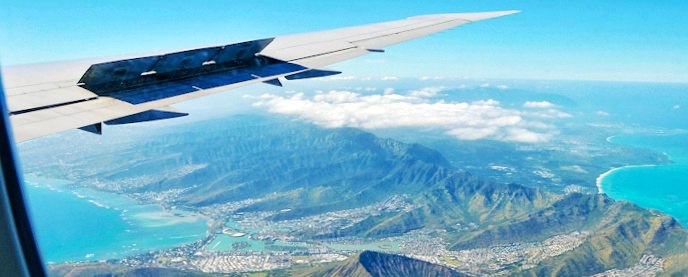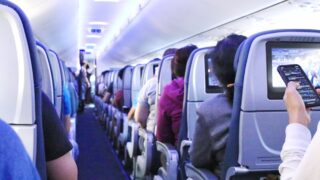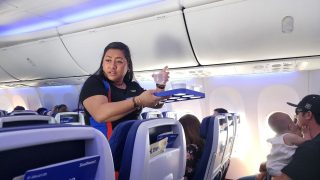An increasing presence of possibly unregulated service animals on flights has created turbulence for passengers and airlines. On a recent flight, UA 362, from Honolulu to Newark, tensions flared when a Premium Economy traveler with a 9-month-old baby encountered a hyperactive pit bull close to them labeled a “service animal in training.”
This incident on United Airlines highlights growing concerns over the balance between accommodating travelers with disabilities and ensuring the safety and comfort of others. Read on and comment if you think the airline handled the situation correctly that caused the family with the baby to disembark for fear of safety.
Long-haul Hawaii flights, which often involve families and extended travel times, are particularly vulnerable to the challenges of enforcing service animal policies. Airlines are now navigating a complex minefield of legal requirements, passenger expectations, and operational constraints.
A troubling incident in the sky.
The situation unfolded when a passenger boarding a Hawaii flight noticed a dog, identified as a pit bull, behaving aggressively and wearing a vest that read “service animal in training.” Concerned for the safety of their nine-month-old child, the passenger raised the issue with the flight crew.
According to other passengers, the dog’s behavior—including snapping and hyperactivity—raised immediate red flags about whether it met the service animal designation criteria and had passed a Public Access Test.
Despite the concerns, United Airlines offered limited solutions. The family could move seats but remained close enough to the dog to feel unsafe. Ultimately, they switched to a different flight, rerouting through a connecting flight in Los Angeles, downgrading to Basic Economy, and enduring a 28-hour travel duration with their baby.
This decision added significant travel time and logistical challenges, including difficulty managing baby formula and medication packed in checked luggage. They had brought enough to cover 12 hours in the air but not 28 hours.
The airline’s decision not to address the dog’s behavior more decisively reflects the broader tension surrounding service animal regulations. While the Air Carrier Access Act allows airlines to exclude disruptive or uncontrolled animals, legal and public relations complications sometimes lead to inaction.
The impact on Hawaii travelers.
Crowded Hawaii flights are uniquely affected by service animal policies due to the long travel times and limited passenger options. The issue extends beyond isolated incidents, raising questions about how airlines can balance competing needs in a confined space. Passengers increasingly report concerns about untrained animals disrupting flights, ranging from noise and allergies to safety risks.
Some travelers have shared frustrations over perceived abuses of service animal policies. These include using vests or certifications that are easy to obtain online but lack official oversight. Service animal vests can be purchased on Amazon for under $20. The line between accommodating legitimate needs and addressing fraudulent claims has become increasingly challenging for airlines.
Service animal rules on flights: what to know.
The rules for service animals on flights are primarily governed by the Air Carrier Access Act (ACAA), which ensures equal access for passengers with disabilities. While federal guidelines establish a baseline for accommodating service animals, airlines have some enforcement discretion, leading to slight policy variations.
Under the ACAA, these animals are defined as dogs individually trained to perform tasks for individuals with disabilities. It’s worth noting that emotional support animals are no longer classified as service animals, and airlines are not required to allow them in the cabin.
To travel with a service animal, passengers must meet specific criteria. This often, but not always, includes providing documentation, such as a DOT Service Animal Air Transportation Form, which confirms the animal’s health, behavior, and training.
For longer flights, like the ten-hour flight from Honolulu to Newark, passengers may also need to attest that the animal will not require unsanitary relief during the journey.
Service animals must always remain under the handler’s control, and airlines may deny boarding to animals displaying aggressive or disruptive behavior. Animals must fit within the passenger’s foot space without obstructing aisles, and airlines can limit the number of service animals passengers can bring. While airlines cannot ban service animals based solely on breed, they may exclude animals based on behavior or safety concerns.
The implementation of these rules can also vary slightly between airlines. For instance, some carriers require advance submission of documentation, while others allow it to be completed at the airport.
Hawaii-bound flights are also subject to the state’s strict animal quarantine laws, which may influence travel plans for service animals.
Airlines must balance the rights of travelers with disabilities and the safety and comfort of all passengers, a challenge that continues to evolve as service animal policies adapt.
Service animals vs. service animals in training on Hawaii flights.
The distinction between a fully trained service animal and one in training is important regarding air travel. Under the Air Carrier Access Act (ACAA), airlines must accommodate fully trained service animals but are not obligated to allow those in training onboard.
A service animal performs specific tasks for a person with a disability. Tasks must directly mitigate the person’s disability, such as guiding someone blind, alerting a person to a seizure, or providing stability for someone with mobility issues. Many fully trained animals have passed a public access test, ensuring they can remain calm, well-behaved, and under control in public spaces, including confined areas like the airplane cabin.
In contrast, a service animal in training is still learning these skills and has not yet met the standards required for public access. Some states may grant legal protections to service animals in training, while ACAA does not require airlines to accommodate them. This confusion means airlines often make case-by-case decisions based on the animal’s behavior, documentation provided, and specific circumstances.
Potential solutions and lessons learned.
Addressing the challenges of service animals on flights is a multifaceted approach that some advocacy groups have called for to be more uniformly regulated, with standardized certifications. Airlines will also benefit from improved crew training to enforce policies consistently and appropriately.
This incident illustrates that travelers should always take proactive steps to prepare for potential disruptions. For long-haul flights, keeping essential items, such as medication and baby supplies, in carry-on luggage is critical.
For those concerned about encountering disruptive animals, understanding passenger rights under the Air Carrier Access Act may become more important in potentially addressing such issues with airline staff.
The incident on the Honolulu-to-Newark flight underscores the need for a more robust and clearly defined system to address the complexities of modern air travel.
How would you have handled the situation?
Photo Credit: Beat of Hawaii.
Get Breaking Hawaii Travel News







This situation (and the ongoing controversy) is completely avoidable!
The Americans with Disabilities Act provides a simple resolution for such situations: the airline (or theater, or restaurant, or….) has the right to remove an animal that us out of control.
Furthermore, FAA regulations Require the canine to remain on the floor at the handler’s feet.
So many silly people
ada.gov/resources/service-animals-2010-requirements/
The policy needs to be modified to make it a rule that the service dog can be placed in the luggage area before the flight or confined in one of the restrooms if acting aggressively during the flight.
The airline made a very poor decision. A service animal in training clearly isn’t fully trained to assist its handler so shouldn’t be allowed on flights. It’s usually the same story from dog owners after their dog shows aggression or bites someone. “Oh, he’s never done that before.” UA owes the family an apology and significant compensation for their inconvenience and additional expenses.
This is a fail on the part of the airlines. The rules are clear. Train your staff and be consistent. Even service animals have rules about their behavior. If they cannot behave the do not belong. This gives those of us who actually raise service animals a bad name and makes our efforts much more difficult.
I can’t understand why the hyper dog, “in training “, and it’s handler weren’t asked to exit the plane and calm down before catching another flight.
The whole pitbull stigma is so out of control. However I don’t care if it’s a service animal or not any dog of any breed should be muzzled on a flight & as a 2 dog mom it breaks my heart to say & do that but it is for everyone’s safety i do not care how many times a dog has flown there’s too much emotion & too many people in an inclosed area.
I personally would love to go to Hawaii However with 2 dogs an Amstaff/Rottweiler mix & a Husky/Pit mix i know it’s just not possible..
It’s responsible pet ownership even the tiniest dog or most friendly dog can get spooked & bite at the drop of a hat..sometimes literally.
On the East coast, dogs are not allowed to fly if the temperature is above 75 or 80 degrees. I had to fly my dog from Dulles to Miami and was relieved it was low enough in Miami. I just wouldnt fly my dog if it was warm. Although she breathes better than a pug she has a thick coat of hair. Part of the responsibility is the owners for flying a dog like a pug when it was hot
Know your breed and its limitations.
If the dog is in training, I think it a wise and helpful thing to ask the handler if there is anything we could do to help him feel calmer. It would also be really helpful if passengers were given a heads up before they got to the airport. The long Hawaiian flights really requires all passengers to find their friendly bone and having a dog on board is no different.
It’s really dumb to just worry about the breed, I’ve had many dogs, and given the right circumstances any dog could lash out. I currently have a cat who knows when I have a migraine before I do. He comes and lays across my neck. He is not allowed to become a service animal. Only dogs can get that title (i think). We should help to train any who needs it. If they are not a good match then at least it’s been fully examined.
Actually cats, ducks, lizards, birds, can be a support animal Pretty much anything these days If your cat helps you you might wanna look into it.
If the dog was demonstrating aggressive behavior and hyperactivity, it should have been removed from the flight for the safety of all passengers.
Given none of us where there we do not know or seen the actual behavior of the dog, so in all fairness to the dog we can not pass judgement.
These days if you sneeze wrong you are kicked off a flight so I am apt to believe it was not that bad.
The airlines just are not playing games with people or pets these days.
Again, as I said dogs really do not belong on planes anymore then they belong in the grocery store.
Not unless they are muzzled. It’s for the saftey of everyone involved. It is responsible pet ownership.
They can be crated & put in cargo. The area in a plane is just too small, too many smells, too many emotions, kids crying, too many people.
Pitbulls get a very bad rap they are some highly intelligent loving well behaved dogs. I have an American Staffordshire Terrier/ Rottweiler mix who is an incredible dog but he is way too big, bulky, and automatically feared due to his size and breed.
While I will add my Husky /Pit mix she would just eat the plane.
According to the story, this “service dog in training” did Not meet basic regulations. The ACAA states that the dog must remain calm, well-behaved, and under control in public spaces, including confined areas like the airplane cabin. This dog clearly was not well behaved or calm. “According to other passengers, the dog’s behavior—including snapping and hyperactivity—raised immediate red flags about whether it met the service animal designation criteria and had passed a Public Access Test.”
I feel that the airline made a huge mistake, allowing an out of control aggressive dog, who clearly was not in compliance with the regulations, to remain on board, and seriously inconvenienced a family with a baby instead. There is no excuse for such a poor decision. They owe compensation to the family for the cost of the flight and other expenses incurred. And they need to re examine their decision, to ensure that it doesn’t happen again.
My wife has severe allergies to cats and dogs. So much so that 15 minutes of exposure could be deadly. We were on a flight where the FA announced that they would not be serving peanuts due to a passenger have an allergy. Ok, I understand that. But no consideration for someone with pet allergies. Last time that happened a person in the aisle across from us had a cat in a carrier. When I explained our situation to the FA, I was told “it is only a 90 minute flight.” They made no effort to remove the cat. We got off and took a later flight. I was not going to risk my wife for a stupid airline. So: a)I will never fly that airline again; b) I tell as many people as I can not to fly them also. There needs to be a process to license these animals, Huge fines for violating said laws for the airline and passenger, and put all animals in the rear of the plane with some sort of barrier. Or put animals of all kinds in the cargo hold.
Sorry to sound harsh. But someone with allergies should understand the being in. Public thing. Someone could have cat or husky hair on them even at church so that argument is just being selfish because again a person with pet hair on their shirt could aggravate allergies which is why they have created meds for that